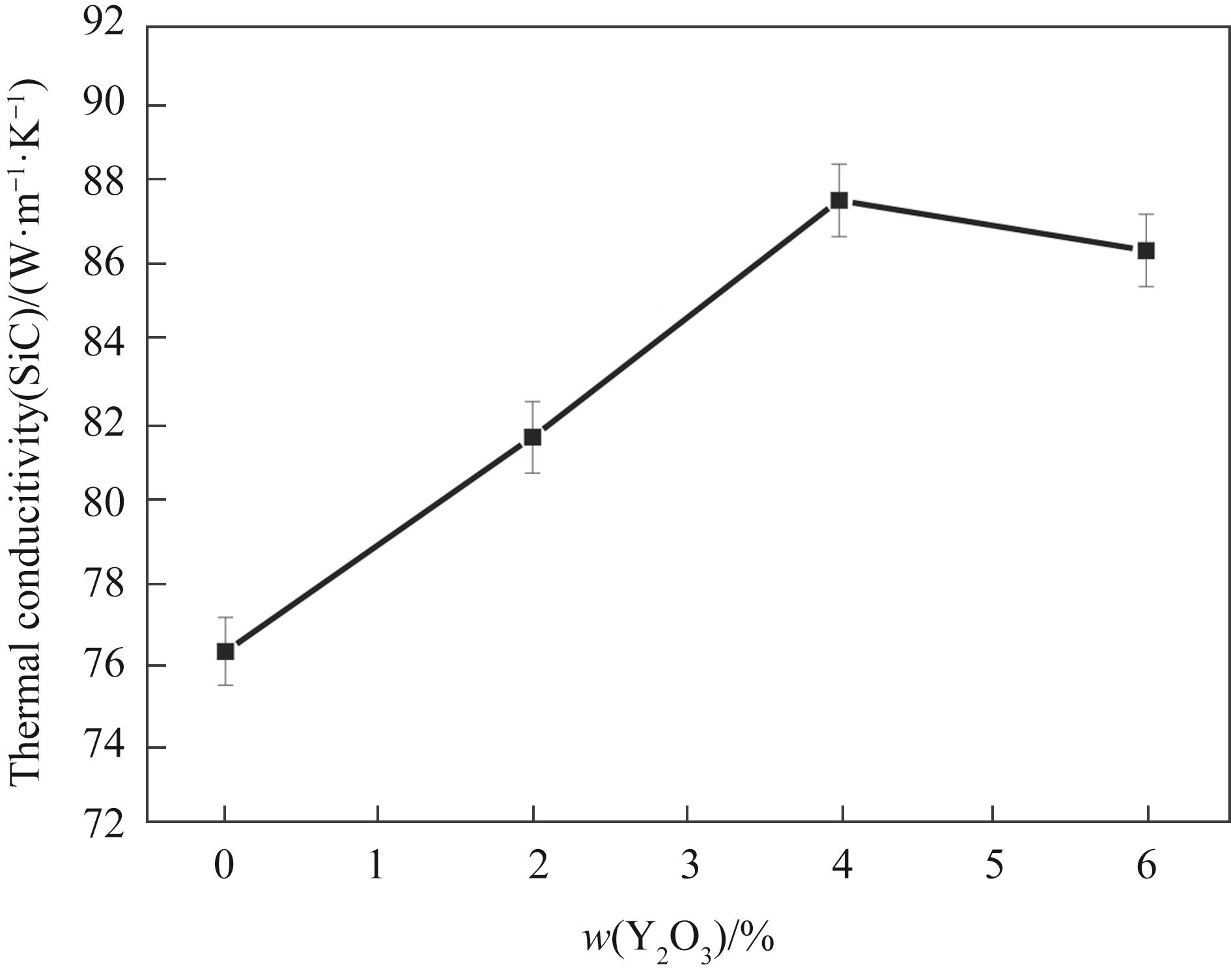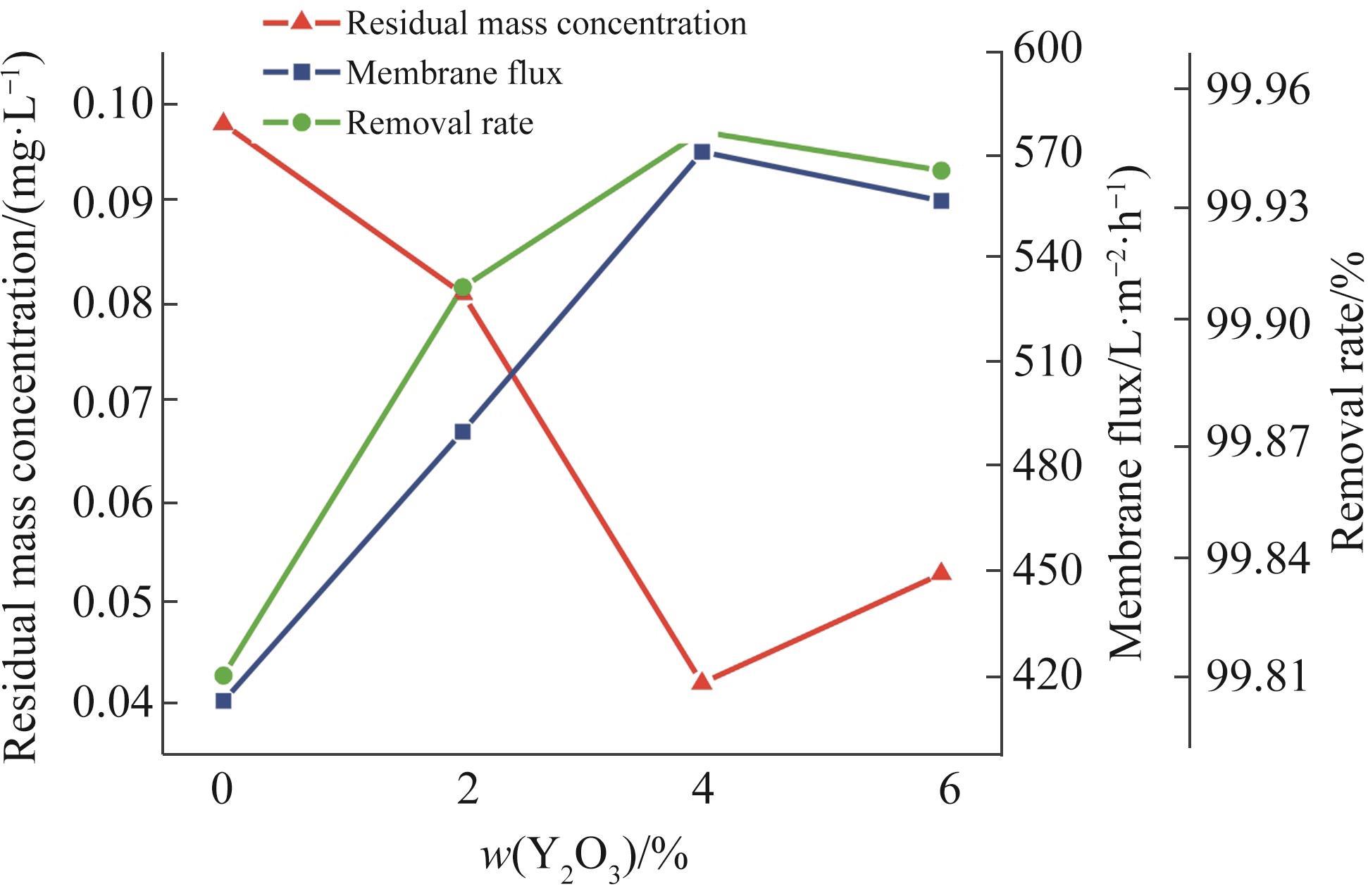
Chinese Journal of Applied Chemistry ›› 2022, Vol. 39 ›› Issue (8): 1312-1318.DOI: 10.19894/j.issn.1000-0518.210469
• Full Papers • Previous Articles Next Articles
Preparation of Y2O3⁃Dopped SiC Ceramics by Micro⁃oxidation Sintering and Removal of Cd2+ in Mimic Wastewater
Bing WANG( ), Min TANG, Ying WANG, Zhi-Guang LIU
), Min TANG, Ying WANG, Zhi-Guang LIU
- Henan Anyang Ecological Environmental Monitoring Center,Anyang 455000,China
-
Received:2021-09-17Accepted:2022-01-10Published:2022-08-01Online:2022-08-04 -
Contact:Bing WANG -
About author:379928820@qq.com
CLC Number:
Cite this article
Bing WANG, Min TANG, Ying WANG, Zhi-Guang LIU. Preparation of Y2O3⁃Dopped SiC Ceramics by Micro⁃oxidation Sintering and Removal of Cd2+ in Mimic Wastewater[J]. Chinese Journal of Applied Chemistry, 2022, 39(8): 1312-1318.
share this article
Add to citation manager EndNote|Ris|BibTeX
URL: http://yyhx.ciac.jl.cn/EN/10.19894/j.issn.1000-0518.210469
Y2O3质量分数 w(Y2O3)/% | 密度 ρ/(g·cm-3) | 热导率 Thermal conductivity/(W·m-1·K-1) | 残留浓度 Residual concentration/(mg·L-1) | 膜通量 Membrane flux/ (L·m-2·h-1) | 去除率 Removal rate/% |
|---|---|---|---|---|---|
| 0 | 1.85 | 76.35 | 0.098 | 415 | 99.81 |
| 2 | 2.03 | 81.71 | 0.081 | 492 | 99.91 |
| 4 | 2.19 | 87.64 | 0.042 | 572 | 99.95 |
| 6 | 2.21 | 86.39 | 0.0516 | 558 | 99.94 |
Table 1 Performance parameters of porous SiC ceramics
Y2O3质量分数 w(Y2O3)/% | 密度 ρ/(g·cm-3) | 热导率 Thermal conductivity/(W·m-1·K-1) | 残留浓度 Residual concentration/(mg·L-1) | 膜通量 Membrane flux/ (L·m-2·h-1) | 去除率 Removal rate/% |
|---|---|---|---|---|---|
| 0 | 1.85 | 76.35 | 0.098 | 415 | 99.81 |
| 2 | 2.03 | 81.71 | 0.081 | 492 | 99.91 |
| 4 | 2.19 | 87.64 | 0.042 | 572 | 99.95 |
| 6 | 2.21 | 86.39 | 0.0516 | 558 | 99.94 |
| 1 | 王浩, 王建华. 中国水资源与可持续发展[J]. 中国科学院院刊, 2012, 27(3): 352-358, 331. |
| WANG H, WANG J H. Water resources and sustainable development in China[J]. Bull Chinese Acad Sci, 2012, 27(3): 352-358, 331. | |
| 2 | 吴丹, 曹思奇, 康雪, 等. 我国水治理现状评估与展望[J]. 水利水电科技进展, 2019, 39(1): 7-14. |
| WU D, CAO S Q, KANG X, et al. Assessment and prospects of the current situation of water governance in my country[J]. Prog Water Resour Hydropower Sci Technol, 2019, 39(1): 7-14. | |
| 3 | 刘军, 杨胜红, 王婷婷. 浅谈我国水资源现状[J]. 城市建设理论研究(电子版), 2017(13): 251-252. |
| LIU J, YANG S H, WANG T T. On the status quo of my country's water resources[J]. Theor Res Urban Constr (Electron Ed), 2017(13): 251-252. | |
| 4 | 凌琪, 陈婷娜, 伍昌年, 等. 酸改性高岭土对含Cd2+和Pb2+废水的吸附研究[J]. 洛阳理工学院学报(自然科学版), 2018, 28(3): 4-9, 16. |
| LING Q, CHEN T N, WU C N, et al. Adsorption of Cd2+ and Pb2+ wastewater by acid-modified kaolin[J]. J Luoyang Inst Technol (Nat Sci Ed), 2018, 28(3): 4-9, 16. | |
| 5 | HAMOUDI S A, HAMDI B, BRENDLE J. Removal of ions Pb2+ and Cd2+ from aqueous solution by containment geomaterials[J]. Exergetic, Energy Environ Dimen, 2018: 1029-1043. |
| 6 | 程珊珊, 杨锡洪, 章超桦, 等. 垃圾渗滤液水溶性有机物对土壤吸附重金属Cd2+、Pb2+的影响[J]. 水产学报, 2011, 35(3): 410-416. |
| CHNG S S, YANG X H, ZHANG C H, et al. Effects of water-soluble organic matter in landfill leachate on soil adsorption of heavy metals Cd2+ and Pb2+[J]. J Fisher China, 2011, 35(3): 410-416. | |
| 7 | ZHANG Q R, DU W, PAN B C, et al. A comparative study on Pb2+, Zn2+ and Cd2+ sorption onto zirconium phosphate supported by a cation exchanger[J]. J Hazard Mater, 2008, 152(2): 469-475. |
| 8 | 袁健, 钱雅洁, 薛罡, 等. 活性污泥水热碳化法制备磁性炭及对水体Cd2+及Pb2+的去除[J]. 环境工程, 2020, 38(2): 55-62. |
| YUAN J, QIAN Y J, XUE G, et al. Preparation of magnetic carbon by hydrothermal carbonization of activated sludge and its removal of Cd2+ and Pb2+ in water[J]. Environ Eng, 2020, 38(2): 55-62 . | |
| 9 | 申利国, 林红军. 含TiO2杂化分离膜工艺污水处理应用研究综述[J]. 净水技术, 2017, 36(4): 48-56. |
| SHEN L G, LIN H J, Summary of research on wastewater treatment application of TiO2 hybrid separation membrane process[J]. Water Purif Technol, 2017, 36(4): 48-56. | |
| 10 | JIA X, JIN D, LI C, et al. Characterization and analysis of petrochemical wastewater through particle size distribution, biodegradability, and chemical composition[J]. Chinese J Chem Eng, 2019, 27(2): 444-451. |
| 11 | 王竹梅, 李月明, 万德田, 等. 二氧化硅包裹铋基黄色料的制备及其稳定性[J]. 应用化学, 2020, 37(1): 109-116. |
| WANG Z M, LI Y M, WAN D T, et al. Preparation and stability of silica coated bismuth-based yellow pigments[J]. Chinese J Appl Chem, 2020, 37(1): 109-116. | |
| 12 | 陈崇来, 张文霞, 裘建平, 等. 堇青石蜂窝陶瓷负载锰氧化物催化分解臭氧性能[J]. 应用化学, 2020, 37(11): 1293-1300. |
| CHEN C L, ZHANG W X, QIU J P, et al. Catalytic decomposition of ozone by manganese oxide supported on cordierite honeycomb ceramics[J]. Chinese J Appl Chem, 2020, 37(11): 1293-1300. | |
| 13 | 余炎子, 李传刚, 鄢恒飞, 等. 多孔碳化硅陶瓷膜分离技术的应用研究进展[J]. 工业水处理, 2021, 41(5): 41-45. |
| YU Y Z, LI C G, YAN H F, et al. Research progress in the application of porous silicon carbide ceramic membrane separation technology[J]. Ind Water Treatment, 2021, 41(5): 41-45. | |
| 14 | 陈俐. 多孔SiC陶瓷膜的制备与废水处理性能的表征[J]. 功能材料, 2020, 51(12): 12204-12208. |
| CHEN L. Preparation of porous SiC ceramic membrane and characterization of wastewater treatment performance[J]. Funct Mater, 2020, 51(12): 12204-12208. | |
| 15 | HA J H, LEE S, BUKHARI S, et al. Effects of preparation conditions on the membrane properties of alumina-coated silicon carbide supports[J]. J Ceram Soc Jpn, 2018, 126(10): 860-869. |
| 16 | 曹婷婷, 许铁夫, 王淼, 等. 陶瓷膜处理采油废水的离子去除特性及膜污染分析[J]. 给水排水, 2018, 54(5): 60-64. |
| CAO T T, XU T F, WANG M, et al. Ion removal characteristics and membrane fouling analysis of ceramic membrane in the treatment of oil production wastewater[J]. Water Wastewater, 2018, 54(5): 60-64. | |
| 17 | 万意, 李东辉, 唐玉刚, 等. 碳化硅膜处理PTA精制废水技术研究[J]. 合成技术及应用, 2020, 35(3): 28-32. |
| WAN Y, LI D H, TANG Y G, et al. Research on PTA refining wastewater treatment technology with silicon carbide membrane[J]. Synth Technol Appl, 2020, 35(3): 28-32. | |
| 18 | 王竹梅, 马振国, 李月明, 等. Ca2+离子掺杂对γ-Ce2S3合成温度及热稳定性的影响[J]. 应用化学, 2019, 36(6):683-689. |
| WANG Z M, MA Z G, LI Y M, et al. Effect of Ca2+-doping on synthesis temperature and heat stability of γ-Ce2S3[J].Chinese J Appl Chem, 2019, 36(6): 683-689. | |
| 19 | 代小元, 沈凡, 戴武斌, 等. 碳化硅陶瓷膜处理工业废水的工艺特性研究[J]. 武汉工程大学学报, 2018, 40(3):284-287. |
| DAI X Y, SHEN F, DAI W B, et al. Study on the process characteristics of silicon carbide ceramic membrane for industrial wastewater treatment[J]. J Wuhan Inst Technol, 2018, 40(3): 284-287. | |
| 20 | 张瑶瑶, 艾超前, 杜毅帆, 等. 碳化硅多孔陶瓷表面活化改性及其吸附Pb(Ⅱ)的研究[J]. 中国陶瓷, 2019, 55(4): 18-24. |
| ZHANG Y Y, AI C Q, DU Y F, et al. Surface activation modification of silicon carbide porous ceramics and its adsorption of Pb(Ⅱ)[J]. China Ceram, 2019, 55(4): 18-24. | |
| 21 | 葛荣树, 张丽芳, 张彤, 等. 纳米MoS2对水中重金属离子去除效果的研究[J]. 科技创新导报, 2018(30): 76-78. |
| GE R S, ZHANG L F, ZHANG T, et al. Research on the removal of heavy metal ions in water by nano-MoS2[J]. Sci Technol Innovat Herald, 2018(30): 76-78. |
| [1] | Yi-Chen YU, Yu-Chen ZHANG, Yao-Yuan ZHANG, Qin WU, Da-Xin SHI, Kang-Cheng CHEN, Han-Sheng LI. Research Progress of Bulk Metal Oxides for Non-oxidative Propane Dehydrogenation [J]. Chinese Journal of Applied Chemistry, 2023, 40(6): 789-805. |
| [2] | Xiao DUAN, Feng CAO, Yang ZHOU, Bin ZHANG, Wei-Wen DONG, Ling-Li WEI, Jia LI, Jian-Guo LIU. High Precision Non-Destructive Test Method of Pt Loading and Distribution in Proton Exchange Membrane Fuel Cell Membrane Electrodes [J]. Chinese Journal of Applied Chemistry, 2023, 40(6): 845-852. |
| [3] | Lin-Tao YANG, Mao LI. Molecular-Mass and Its Distribution Analysis of n-Alkylated Poly(p-phenylene terephthamide) [J]. Chinese Journal of Applied Chemistry, 2023, 40(6): 853-859. |
| [4] | Xin-Tao XIE, Sang-Ni JIANG, Xi-Fei YU. Selective Binding pH Responsive Liposomes with Phenylboronic Acid for Drug Delivery [J]. Chinese Journal of Applied Chemistry, 2023, 40(6): 860-870. |
| [5] | Jia-Zheng LI, Shu-Zhong HE. Research Progress of Total Synthesis of Polygalolides [J]. Chinese Journal of Applied Chemistry, 2023, 40(5): 615-624. |
| [6] | Hai-Xiang XIU, Wan-Qiang LIU, Dong-Ming YIN, Yong CHENG, Chun-Li WANG, Li-Min WANG. Research Progress of AB2 Laves Phase Hydrogen Storage Alloys [J]. Chinese Journal of Applied Chemistry, 2023, 40(5): 640-652. |
| [7] | Peng-Hui FAN, Jie LIU, Sheng-Hui LOU, Tao TANG. Research Progress on Synergists of Phosphorous Flame Retardants in Epoxy Resin [J]. Chinese Journal of Applied Chemistry, 2023, 40(5): 653-665. |
| [8] | Xue-Bo LEI, Hui-Jing LIU, He-Yu DING, Guo-Dong SHEN, Run-Jun SUN. Research Progress on Photocatalysts for Degradation of Organic Pollutants in Printing and Dyeing Wastewater [J]. Chinese Journal of Applied Chemistry, 2023, 40(5): 681-696. |
| [9] | Yuan-Hua ZHANG, Sheng-Ran LI, Xi-Fei YU. Fluoride-Functionalized Choline Phosphate Liposomes for Oral Insulin Administration [J]. Chinese Journal of Applied Chemistry, 2023, 40(5): 730-742. |
| [10] | Xiao-Lin LAN, Hong-Xing ZHENG, Yi-Fan ZHANG, Zhen ZHAO, He-Ye XIAO, Zhi-Jiang WANG, Peng-Yang DENG. Research Progress on Preparation of SiC Ceramic Powders by Atmospheric High Temperature Solid Phase Reaction [J]. Chinese Journal of Applied Chemistry, 2023, 40(4): 476-485. |
| [11] | Yu-Chen TAO, Xiao-Hui HOU, Deng-Ke YIN, Ye YANG. Effect of Electric Field-Regulating Cholesterol-based Liquid Crystal Films on the Growth and Differentiation of Fibroblasts [J]. Chinese Journal of Applied Chemistry, 2023, 40(4): 546-553. |
| [12] | Jin-Li ZHAO, Zong-Ren YU, Bo-Min SU. Analysis of Egg Whites from Burial Murals by Pyrolysis-Gas Chromatography/Mass Spectrometry [J]. Chinese Journal of Applied Chemistry, 2023, 40(4): 562-570. |
| [13] | Fang-Zheng HU, Xing GAO, Lei LIU, Tian-Heng YUAN, Ning CAO, Kai LI, Ya-Tao WANG, Jian-Hua LI, Hui-Qin LIAN, Xiao-Dong WANG, Xiu-Guo CUI. Advances in Black Phosphorus Anode Advantages and Optimization in Li-ion Battery Anodes [J]. Chinese Journal of Applied Chemistry, 2023, 40(4): 571-582. |
| [14] | Peng BU, Hong-Liang LI. Preparation and Upconversion Luminescence Study of Rare Earth Yb3+/Tm3+ Doped NaGd(MO4)2 Phosphors [J]. Chinese Journal of Applied Chemistry, 2023, 40(3): 374-379. |
| [15] | Jin-Jian LIU, Yi-Wei LU. Multiple-Responsive Coordination Polymers Based on a Carboxybenzyl Viologen Ligand [J]. Chinese Journal of Applied Chemistry, 2023, 40(3): 397-403. |
| Viewed | ||||||
|
Full text |
|
|||||
|
Abstract |
|
|||||






